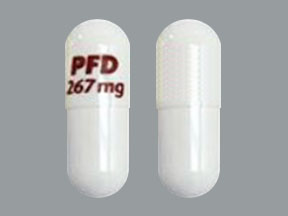Esbriet Disease Interactions
There are 3 disease interactions with Esbriet (pirfenidone).
Pirfenidone (applies to Esbriet) hepatic impairment
Moderate Potential Hazard, Moderate plausibility. Applicable conditions: Liver Disease
Increases in ALT and AST (>3 x ULN) with or without concomitant elevations in bilirubin, have been reported in patients treated with pirfenidone. These findings were reversible with dose modification or treatment discontinuation. Conduct liver tests prior to therapy initiation in all patients, then monthly for the first 6 months and every 3 months thereafter. Dose modification or interruption may be necessary for liver enzyme elevations. Pirfenidone should be used with caution in patients with mild to moderate hepatic impairment, monitoring adverse reactions. The safety and efficacy of pirfenidone has not been studied in patients with severe hepatic impairment, and is not recommended for use in these patients.
Pirfenidone (applies to Esbriet) renal impairment
Moderate Potential Hazard, Moderate plausibility. Applicable conditions: Renal Dysfunction
Pirfenidone should be used with caution in patients with mild, moderate, or severe renal impairment, monitoring for adverse reactions and considering dosage modifications or discontinuation as needed. The safety and efficacy of pirfenidone has not been studied in patients with end-stage renal disease requiring dialysis, so its use is not recommended in these patients.
Pirfenidone (applies to Esbriet) smoking
Moderate Potential Hazard, Moderate plausibility.
Smoking causes decreased exposure to pirfenidone, which may alter its efficacy. Patients should be instructed to stop smoking prior to treatment, and to avoid smoking while taking pirfenidone.
Switch to professional interaction data
Esbriet drug interactions
There are 163 drug interactions with Esbriet (pirfenidone).
Esbriet alcohol/food interactions
There are 2 alcohol/food interactions with Esbriet (pirfenidone).
More about Esbriet (pirfenidone)
- Esbriet consumer information
- Check interactions
- Compare alternatives
- Pricing & coupons
- Reviews (11)
- Drug images
- Side effects
- Dosage information
- During pregnancy
- Generic availability
- FDA approval history
- Drug class: miscellaneous uncategorized agents
- En español
Related treatment guides
Drug Interaction Classification
| Highly clinically significant. Avoid combinations; the risk of the interaction outweighs the benefit. | |
| Moderately clinically significant. Usually avoid combinations; use it only under special circumstances. | |
| Minimally clinically significant. Minimize risk; assess risk and consider an alternative drug, take steps to circumvent the interaction risk and/or institute a monitoring plan. | |
| No interaction information available. |
See also:
Further information
Always consult your healthcare provider to ensure the information displayed on this page applies to your personal circumstances.


